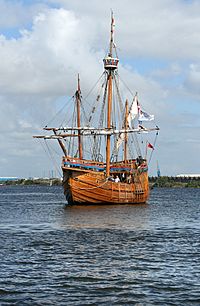Matthew (ship) facts for kids
class="infobox " style="float: right; clear: right; width: 315px; border-spacing: 2px; text-align: left; font-size: 90%;"
| colspan="2" style="text-align: center; font-size: 90%; line-height: 1.5em;" | 
|} The Matthew was a famous sailing ship from the 1400s. It was a type of ship called a caravel, which was known for being fast and easy to steer. In 1497, a brave explorer named John Cabot sailed the original Matthew from Bristol, England, all the way across the Atlantic Ocean to North America. This journey was a very important part of the Age of Discovery, when Europeans were exploring new parts of the world. Today, there's a beautiful replica (a copy) of The Matthew that you can see in Bristol.
Contents
| History | |
|---|---|
| England | |
| Name | The Matthew |
| Builder | Storms'l Services |
| Laid down | 1994 |
| Launched | 1996 |
| Homeport | Bristol |
| General characteristics | |
| Type | replica caravel |
| Displacement | 85 |
| Tons burthen | 50 |
| Length | Length overall: 78 ft (24 m) |
| Beam | 20 ft 6 in (6.25 m) |
| Height | 72.5 ft 6 in (22.25 m) |
| Draught | 7 ft 6 in (2.29 m) |
| Decks | 2 |
| Installed power | 200hp Caterpillar 3116 |
| Propulsion | sail, engine |
| Sail plan | caravel |
The Matthew: A Famous Ship
The original Matthew was a small but strong ship. It weighed about 50 tons. This made it quick and easy to handle on the open sea. The ship was a caravel, a type of sailing vessel popular in the 15th and 16th centuries. Caravels had special sails that allowed them to sail against the wind. This was a big advantage for explorers.
Who Was John Cabot?
John Cabot was an Italian explorer. He was given permission by King Henry VII of England to explore new lands. Cabot believed he could find a shorter route to Asia by sailing west across the Atlantic. This was a very bold idea for his time. He hoped to find valuable goods like spices and silks.
The Great Voyage of 1497
Cabot had tried to sail west before, but his first trip didn't get very far. For his second attempt, he decided to use only one ship: the Matthew. This shows how much he trusted the ship.
Setting Sail
The Matthew began its historic journey in 1497. It departed from Bristol, England. The exact date was either May 2nd or May 20th. The ship had a small crew, with only 18 people on board. They first sailed to Dursey Island in Ireland. From there, they set off directly west, aiming for Asia.
Reaching North America
After weeks at sea, the crew finally spotted land. This happened on June 24, 1497. They had reached North America! It was not Asia, but a new continent. Historians still debate the exact spot where they landed. Most likely, it was either Cape Bonavista or St. John's in Newfoundland, Canada. This voyage was a huge step in exploring the world.
About the Replica Ship
The Matthew you see today is a modern replica. It was built in Bristol, England, in the 1990s. The construction started in 1994 and the ship was launched in 1996. This replica helps people imagine what the original voyage was like. It also reminds us of the brave explorers who sailed into the unknown centuries ago. The replica Matthew is a popular attraction in Bristol. It helps keep the history of John Cabot's famous journey alive.

